BROWN ANOLE
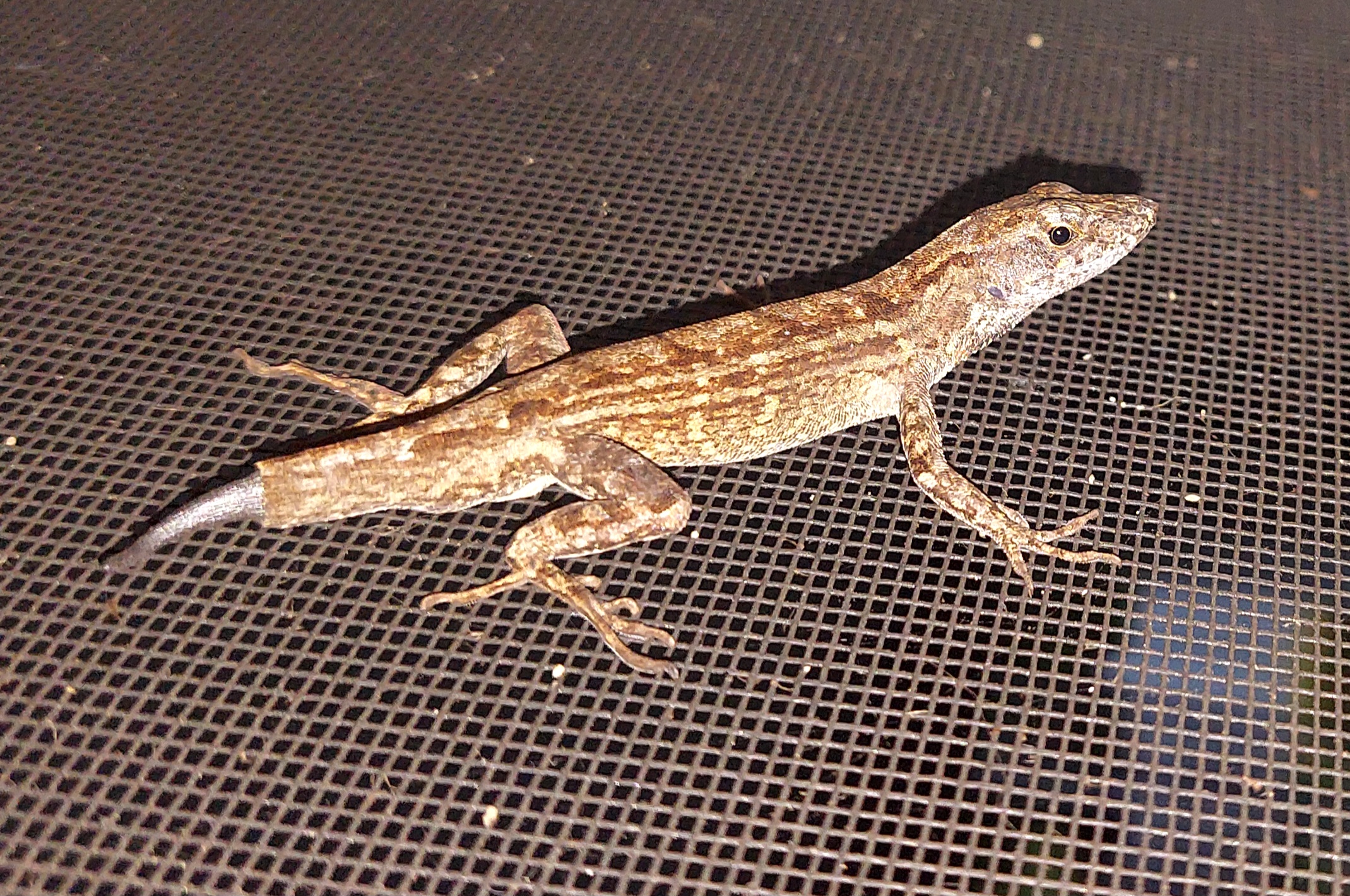
The brown anole (Anolis sagrei), also known as the Bahaman anole or De la Sagra’s Anole, is a lizard native to Cuba and the Bahamas. It has been widely introduced elsewhere, by being sold as a pet lizard, and is now found in Florida and as far north in the United States as southern Georgia, Texas, Louisiana, Mississippi, Alabama, Hawaii, and Southern California. It has also been introduced to other Caribbean islands and Taiwan in Asia.
This species is highly invasive. In its introduced range, it reaches exceptionally high population densities, is capable of expanding its range very quickly, and both outcompetes and consumes many species of native lizards. The brown anole’s introduction into the United States in the early 1970s has altered the behavior and triggered a negative effect on populations of the native Carolina anole (Anolis carolinensis, also known as the green anole), which have generally been relegated to the treetops. The brown anole (Anolis sagrei), or the Bahaman anole, is a lizard native to Cuba and the Bahamas. However, its introduction as a pet lizard has led to its invasive presence in various regions, including the Cayman Islands. This species has established itself as an invader, rapidly colonizing new areas and out-competing native lizard species. Its adaptability and high reproductive rate enable it to reach significant population densities, posing a threat to the local ecosystem. In the Cayman Islands, the brown anole’s invasive nature has the potential to disrupt the delicate balance of the island’s wildlife, warranting efforts to manage and mitigate its impact on the native fauna and environment.
GRAND CAYMAN BLUE ANOLE
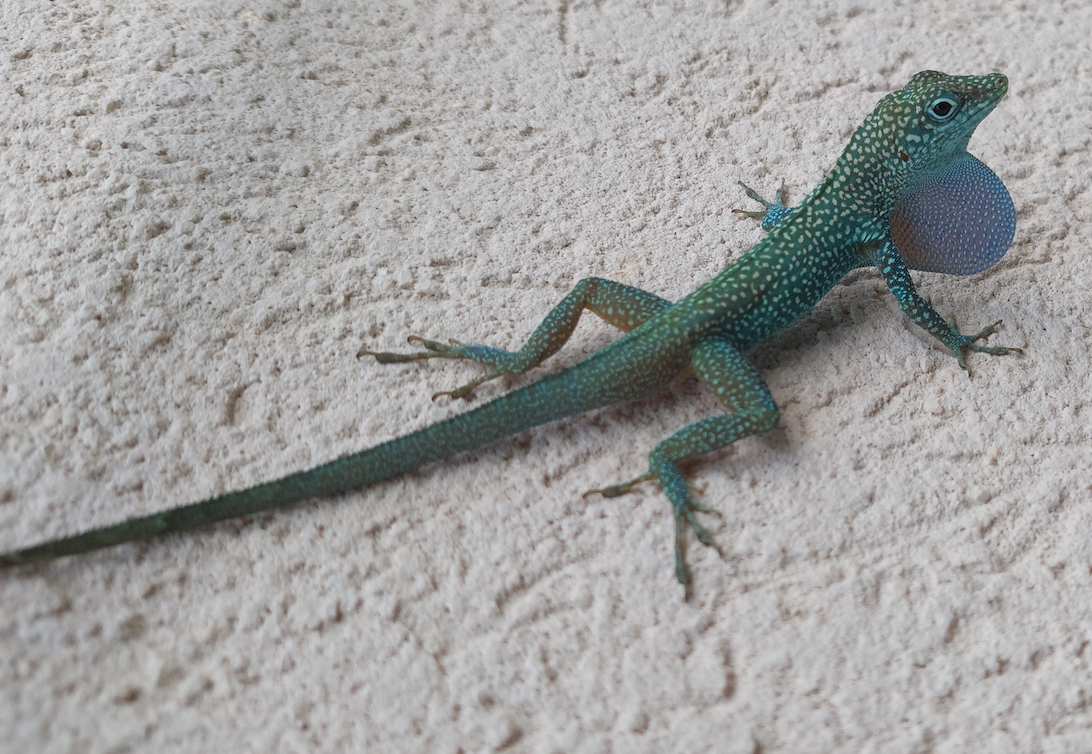
The Grand Cayman Blue Anole (Anolis conspersus), is a captivating reptile endemic to the Cayman Islands. Renowned for its stunning coloration, this anole species showcases shades of iridescent blue that shimmer in the sunlight, making it a true jewel of the islands’ biodiversity. The males of the species often display vibrant blue hues during courtship and territorial displays. These agile climbers are commonly found in forested areas, gracefully maneuvering through foliage in search of insects and small prey. As a native species of the Cayman Islands, the Grand Cayman Blue Anole plays a vital role in maintaining the island’s delicate ecosystem. However, due to habitat loss and other environmental factors, their conservation status warrants attention and efforts to ensure their continued existence.
MAYNARD’S ANOLE
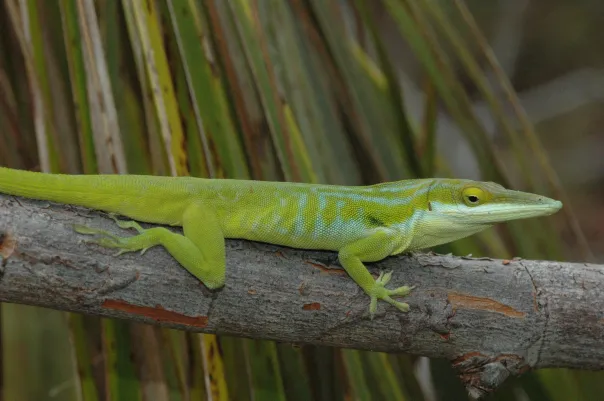
The Maynard’s Anole (Anolis maynardii) stands as a captivating native reptile species of Cayman Brac, one of the enchanting islands within the Cayman archipelago. Interestingly, this remarkable lizard had remained enigmatic until the mid-1980s, with no documented sightings on Cayman Brac despite its close proximity to its native territory, Little Cayman. Remarkably, it was only in 1987 that the Maynard’s Anole was first discovered on Cayman Brac, suggesting a potential human-assisted colonization event. Since then, this small lizard has embarked on a journey of adaptation and expansion, establishing its presence across Cayman Brac. Its ability to thrive in its newfound habitat underscores the species’ resilience and underscores the intricate ways in which life can find its place even in seemingly untouched corners. The Maynard’s Anole’s story serves as a reminder of the interconnectedness of ecosystems and the importance of understanding the dynamics that shape the distribution of species in their natural environments.
GREEN IGUANA

The green iguana (Iguana iguana), also known as the American iguana, is a large, herbivorous lizard native to Central and South America. However, due to its adaptability and the exotic pet trade, the green iguana has become invasive in many regions, including the Cayman Islands. Its introduction has led to disruption of the local habitat and competition with native species such as the Grand Cayman blue iguana. This invasive species has a voracious appetite for vegetation, posing a threat to native plants and creating imbalances in the ecosystem.
The green iguana’s invasive nature on the Cayman Islands prompted a cull to manage its population. In October 2018, a culling project was initiated to address the escalating green iguana population. At the beginning of the cull, it was estimated that around 1.32 million green iguanas inhabited Grand Cayman. Over the first 14 months of the cull, approximately 1.12 million iguanas were culled, significantly reducing the population to just 25,000 by August 2020. This drastic reduction in numbers was a testament to the effectiveness of the culling efforts in curbing the invasive species’ impact on the native ecosystem and biodiversity.
The management of the green iguana population through culling underscores the challenges posed by invasive species in delicate ecosystems like the Cayman Islands. The green iguana’s ability to reproduce rapidly and disrupt native habitats highlights the importance of proactive conservation measures to protect native species and maintain the ecological balance.
GRAND CAYMAN BLUE IGUANA
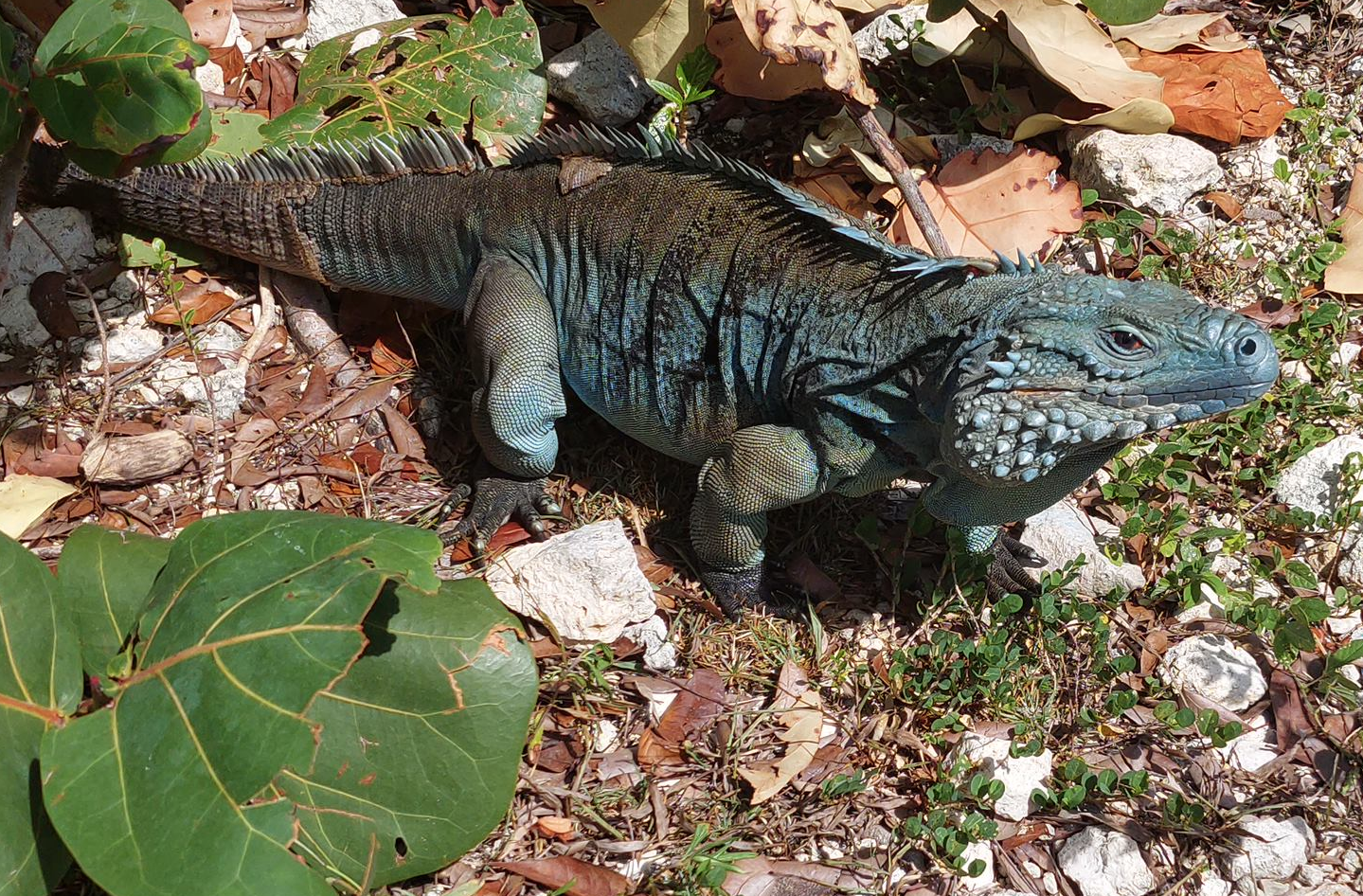
The blue iguana (Cyclura lewisi), also referred to as the Grand Cayman iguana, is an endangered lizard species unique to Grand Cayman Island. Originally considered a subspecies of the Cuban iguana, it was reclassified as a distinct species in 2004 due to genetic differences. Notably long-lived, with a potential lifespan of up to 69 years, the blue iguana is recognized by its tan-to-gray coloration, enhanced by a brilliant bluish hue during the breeding season, particularly in males. It thrives in rocky, sunlit habitats within dry forests or near the shore, where females lay eggs in sand holes during June and July, with a possible second clutch in September. Their diet consists of plants, fruits, and flowers. The species faced a severe decline, with only about 15 wild individuals remaining by 2003, primarily due to predation by feral pets and habitat loss due to agricultural expansion. Conservation efforts, including releasing hundreds of captive-bred iguanas into a protected preserve on Grand Cayman, led by the Durrell Wildlife Conservation Trust and several non-profit organizations in collaboration with the Cayman Islands government, have worked to safeguard the blue iguana’s survival and increase its population.
SISTER ISLES ROCK IGUANA
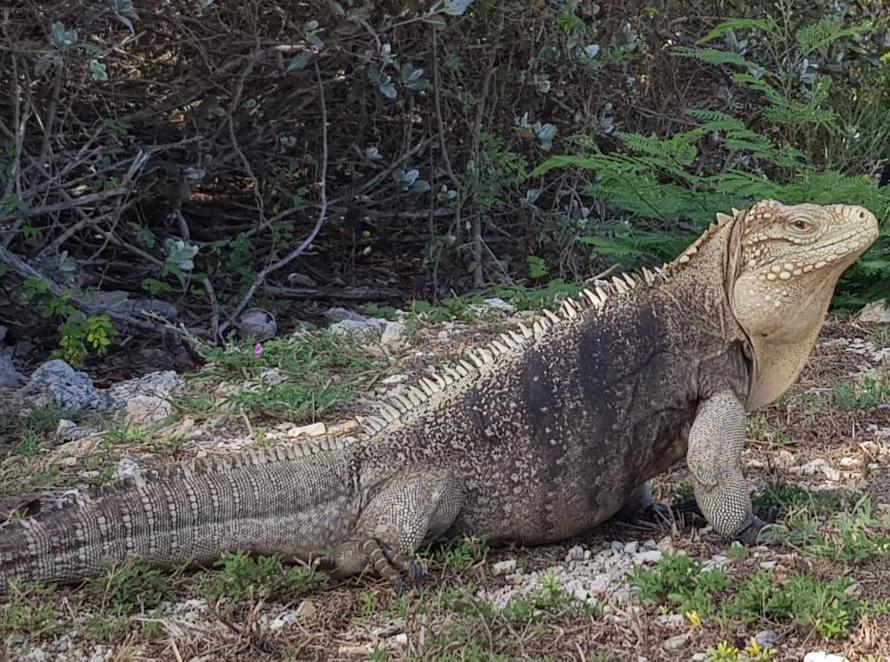
The Sister Isles Rock Iguana (Cyclura nubila caymanensis) is a subspecies native to Little Cayman and Cayman Brac, classified under the Cuban Iguana group. Similar in size to the Grand Cayman Blue Iguana, it can weigh over 20 pounds and displays colors ranging from black to gray or brown, often with highlights of orange, cream, and occasional blue, distinct from the Grand Cayman species.
Once thriving on both islands, the Sister Isles Rock Iguana population has dwindled drastically on Cayman Brac due to threats like free-roaming dogs and feral cats. Only a small relict group now breeds in one southern coastal area, while some adults sighted in West End were translocated from Little Cayman. Although there seems to be a reasonably healthy population on Little Cayman, familiar pressures that imperiled the Grand Cayman Blue Iguanas are now evident. Feral cats pose a threat to young iguanas, while unchecked domestic dogs threaten breeding adults. Roadkill incidents have surged, and habitat destruction looms due to emerging residential developments.
Led by the Durrell Wildlife Conservation Trust, alongside the Cayman Islands Department of Environment and the Blue Iguana Recovery Programme, a project assessed risks to the Sister Isles Rock Iguana. Threats include habitat loss, agricultural activities, predation by introduced pets, disturbance of nesting sites, and road accidents. Human feeding exacerbates the issue, luring iguanas into high-risk zones.
A comprehensive species management plan was formulated after a collaborative meeting involving the National Trust for the Cayman Islands, the Cayman Islands Department of Environment, the International Reptile Conservation Foundation, and local stakeholders in 2011. This plan outlines strategies, deadlines, and responsibilities to augment the population and preempt a decline.
Much like the Grand Cayman Blue Iguana, the Sister Isles Rock Iguana enjoys strict legal protection locally and internationally, only to be handled for authorized conservation efforts. Capturing or moving iguanas from any of the three Cayman Islands is illegal, emphasizing the importance of maintaining separate populations on their respective islands.
CAYMAN CURLY-TAILED LIZARD
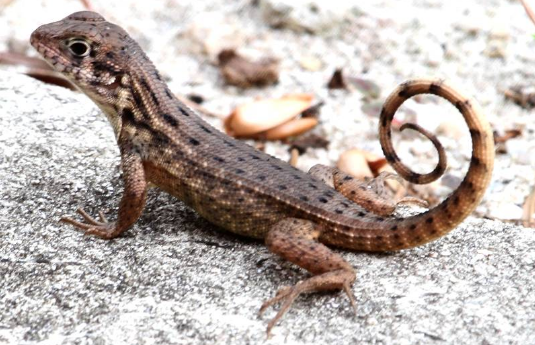
The Cayman Curly-Tailed Lizard (Leiocephalus varius) is a captivating reptile that finds its home in the Cayman Islands. Known for its unique appearance, these lizards feature a distinctive curled tail and intricate patterns on their skin. Their swift movements and agile climbing abilities make them intriguing subjects for nature enthusiasts. As native residents of rocky environments, they have seamlessly adapted to the diverse landscapes of the islands. Beyond their appearance and behavior, the Curly-Tailed Lizard has a versatile diet. As omnivores, they consume a wide range of food sources, including insects, spiders, and other invertebrates. This adaptability allows them to thrive in their natural habitat and contribute to the island’s ecosystem by playing the roles of both predator and consumer. The Curly-Tailed Lizard stands as a testament to the rich biodiversity of the Cayman Islands and the intricate connections that exist within its ecosystem.
CROAKING LIZARD
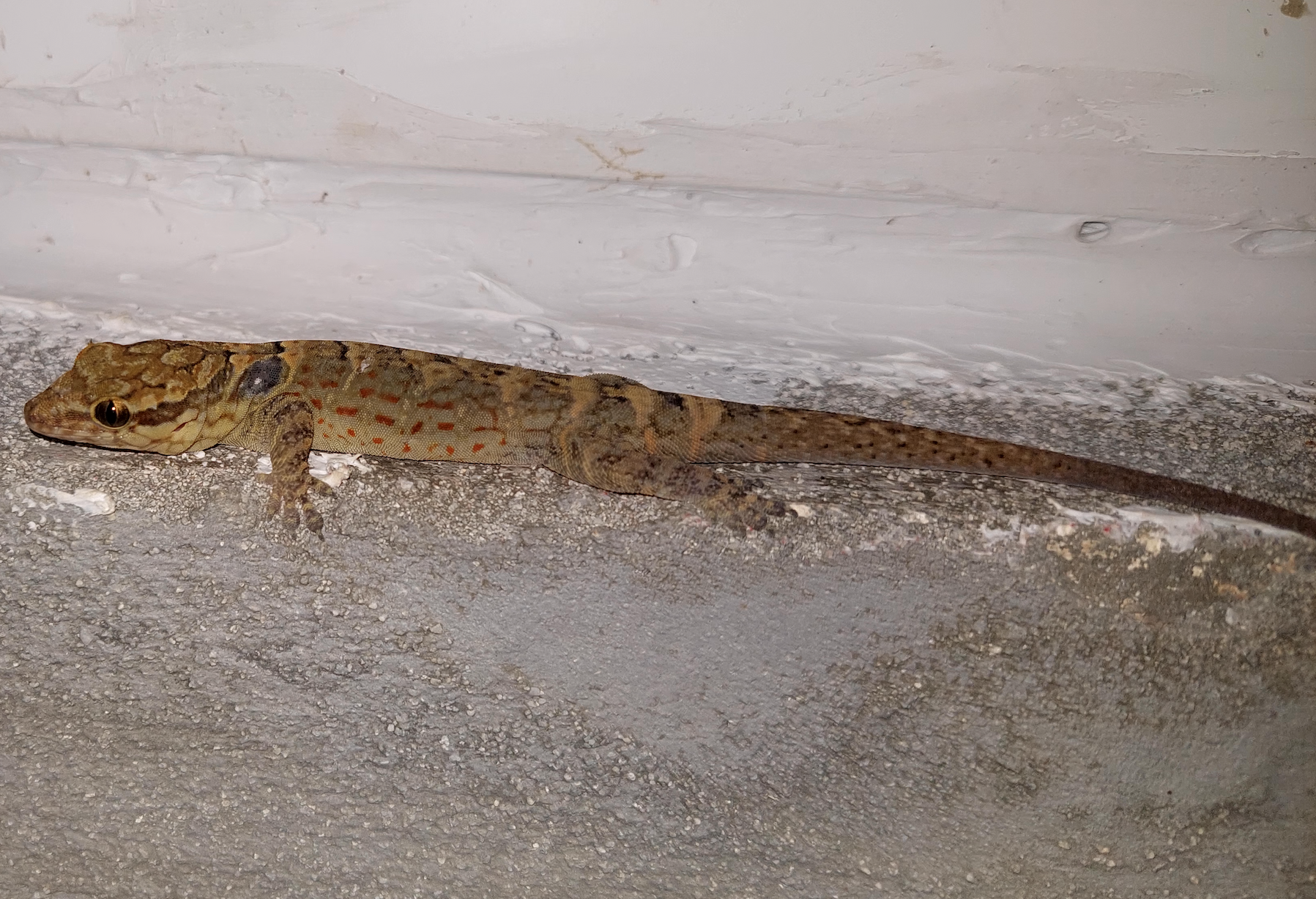
The Croaking Lizard (Aristelliger praesignis) is a fascinating reptile endemic to the Cayman Islands, adding to the unique biodiversity of this Caribbean territory. Recognized for its distinctive vocalizations that resemble a croaking sound, this lizard species has earned its colloquial name. With a vibrant and varied color palette, ranging from brown to gray with intricate patterns, the Croaking Lizard is a captivating sight. Agile climbers, they are often found scaling trees and shrubs in search of insects and other small prey. These lizards are nocturnal, emerging during the night to forage and communicate through their characteristic calls. As part of the islands’ intricate ecosystem, the Croaking Lizard plays an essential role in maintaining the delicate balance of the environment. With its intriguing behaviors and unique vocalizations, it stands as a testament to the hidden wonders of the Cayman Islands’ wildlife.
CAYMAN LEAST GECKO
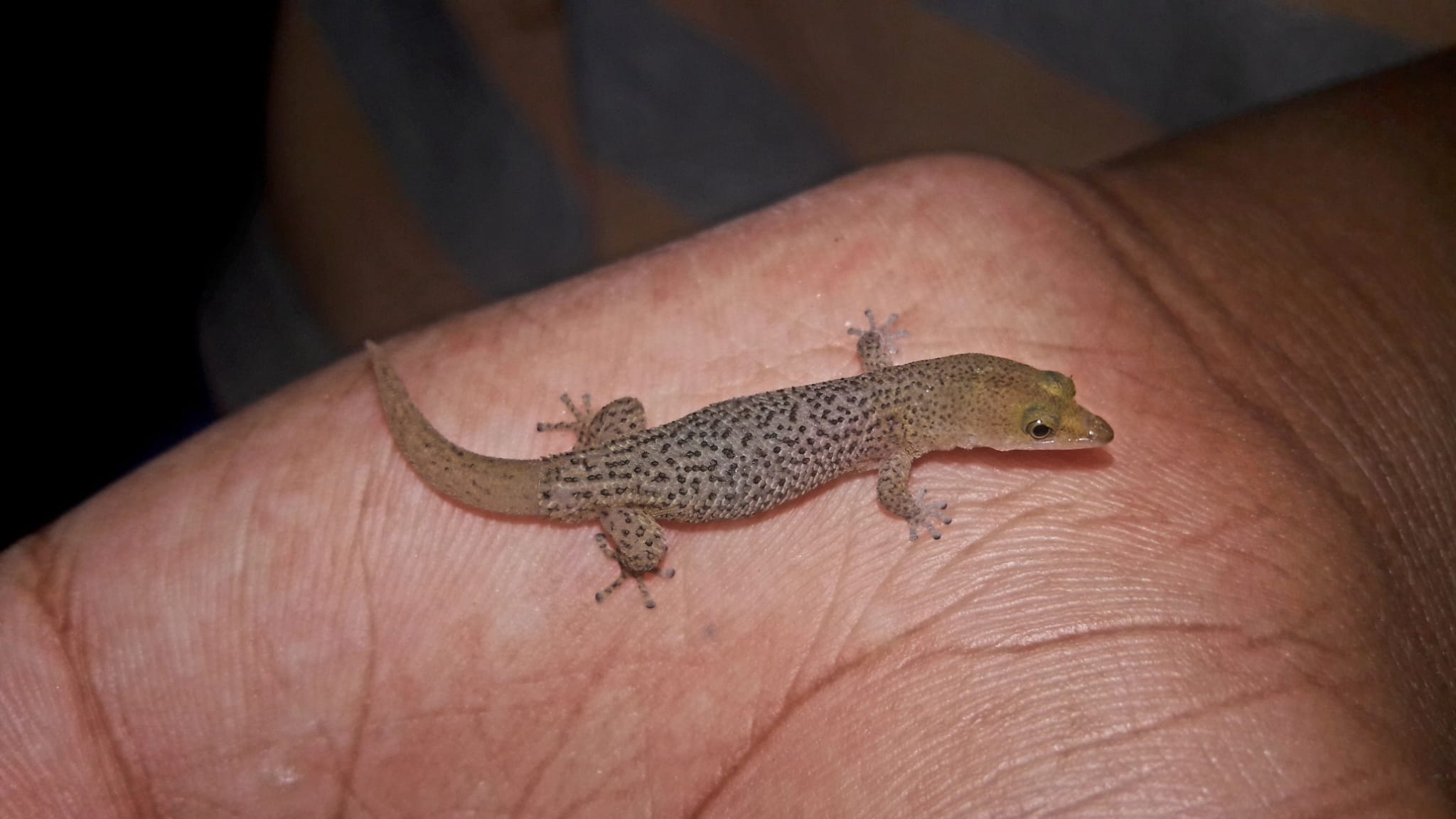
The Cayman Least Gecko (Sphaerodactylus notatus) is a captivating reptile native to the Cayman Islands, specifically Little Cayman and Cayman Brac. Despite its diminutive size, this gecko species holds a special place in the islands’ biodiversity. Its tiny stature, measuring only a few centimeters, belies its significance as an endemic species. Displaying intricate patterns and coloration, ranging from gray to brown with subtle markings, the Cayman Least Gecko is a marvel of adaptation to its environment. Due to its small size, it prefers sheltered habitats and can be found in various nooks and crannies, including beneath rocks and within vegetation. This gecko plays an essential role in controlling insect populations and contributing to the natural balance of its ecosystem. As a testament to the islands’ unique wildlife, the Cayman Least Gecko serves as a reminder of the intricate connections between even the smallest creatures and their environment. While the Cayman Least Gecko is primarily known to be endemic to Little Cayman and Cayman Brac, there have been instances where individuals or small populations have been observed on Grand Cayman.
CAYMAN RACER SNAKE

The Grand Cayman Racer Snake (Cubophis caymanus) is a fascinating reptile endemic to the Cayman Islands, particularly Grand Cayman. This non-venomous snake species has adapted to the island’s varied habitats, including forests, shrublands, and rocky areas. Known for its slender and elongated body, the Grand Cayman Racer showcases various colorations, ranging from shades of green and gray to brown.
Primarily active during the daytime, this snake is skilled at climbing and can be found in trees and vegetation, as well as on the ground. Its diet primarily consists of small vertebrates, such as rodents, lizards and other small animals. The Grand Cayman Racer plays a vital role in the ecosystem by controlling local rodent populations.
Unfortunately, like many native species, the Grand Cayman Racer Snake faces threats such as habitat loss and human interactions. Conservation efforts are important to ensure its survival and maintain the island’s biodiversity. As an integral part of the Cayman Islands’ natural heritage, the Grand Cayman Racer serves as a reminder of the unique wildlife that calls these islands home.
CAYMAN ISLAND DWARF BOA

The Cayman Islands Dwarf Boa (Tropidophis caymanensis) is a captivating and unique snake species that is endemic to the Cayman Islands, specifically Grand Cayman and its surrounding islets. As its name suggests, this boa is characterized by its diminutive size, making it one of the smallest boas in the world. Despite its small stature, the Cayman Islands Dwarf Boa holds significant ecological importance in the islands’ ecosystems.
With a length typically ranging from 30 to 50 centimeters, this snake displays a variety of colors and patterns, including shades of brown, gray, and reddish-brown, often adorned with intricate markings and has a distinct green tail. The Cayman Islands Dwarf Boa is a nocturnal species, most active during the night when it hunts for small prey such as insects and small vertebrates.
Due to its limited distribution on the Cayman Islands, this species is susceptible to habitat loss, invasive species, and human interactions. Conservation efforts are crucial to protecting its population and maintaining the delicate balance of the islands’ ecosystems. As a native reptile, the Cayman Islands Dwarf Boa is a testament to the unique biodiversity of the region and serves as a reminder of the importance of preserving these fragile environments for future generations.
CAYMAN SLIDER TURTLE
The Cayman Slider (Trachemys decussata) or known locally as the hickatee, is a unique and endemic freshwater turtle species found exclusively in the Cayman Islands. With a dark-colored carapace adorned with striking yellow or orange markings on its head, neck, and limbs, the Cayman Slider possesses a distinctive appearance that sets it apart. Inhabiting freshwater habitats such as ponds, marshes, and slow-moving streams, these turtles showcase adaptability to a variety of aquatic environments. Their omnivorous diet consists of aquatic plants, insects, crustaceans, and small aquatic animals. Despite their localized range, Cayman Sliders face threats to their population due to habitat loss and other challenges. As such, efforts to protect and conserve this unique and precious species are essential to ensure its survival and the maintenance of the biodiversity of the Cayman Islands.
GREEN SEA TURTLE

The green sea turtle (Chelonia mydas) is a remarkable marine reptile that roams the tropical and subtropical waters of oceans worldwide. Characterized by its distinctively flattened body and large paddle-like flippers, this species is the only one in its genus, Chelonia. The green sea turtle’s name stems from the green fat found beneath its carapace, while its shell ranges in color from olive to black. These graceful swimmers are primarily herbivores, with a diet consisting mainly of seagrasses and algae. They play a crucial role in maintaining the health of marine ecosystems by helping to control seagrass beds. However, green sea turtles face numerous challenges, including habitat loss, entanglement in fishing gear, poaching, and pollution. Efforts to protect and conserve these turtles have led to their listing as endangered species by international organizations, highlighting the need for global cooperation in safeguarding their populations and the delicate marine ecosystems they inhabit.
The green sea turtle holds a special place in the Cayman Islands as more than just a marine reptile. Beyond its significance to marine ecosystems, the green turtle has become an integral part of the Caymanian culture. It’s not only revered as the main ingredient in the traditional national dish, turtle stew, but also contributes to the islands’ tourism sector. The Cayman Turtle Centre, a renowned attraction, plays a pivotal role in both conservation and education. Originally established to manage the harvesting of green turtles, the center has shifted its focus to preservation. Through dedicated efforts, including captive breeding and hatchling release programs, the center has played a pivotal role in bringing back the green sea turtle population. The conservation success story not only safeguards these turtles but also showcases the potential for collaboration between conservationists, government, and local communities to protect not only a species but also the natural and cultural heritage of the Cayman Islands.
HAWKSBILL SEA TURTLE

The hawksbill sea turtle (Eretmochelys imbricata) is a critically endangered sea turtle belonging to the family Cheloniidae. It is the only extant species in the genus Eretmochelys. The species has a worldwide distribution, with Atlantic and Indo-Pacific subspecies—E. i. imbricata and E. i. bissa, respectively.
The hawksbill’s appearance is similar to that of other marine turtles. In general, it has a flattened body shape, a protective carapace, and flipper-like limbs, adapted for swimming in the open ocean. E. imbricata is easily distinguished from other sea turtles by its sharp, curving beak with prominent tomium, and the saw-like appearance of its shell margins. Hawksbill shells slightly change colors, depending on water temperature. While this turtle lives part of its life in the open ocean, it spends more time in shallow lagoons and coral reefs. The World Conservation Union, primarily as a result of Human fishing practices, classifies E. imbricata as critically endangered.Hawksbill shells were the primary source of tortoiseshell material used for decorative purposes. The Convention on International Trade in Endangered Species outlaws the capture and trade of hawksbill sea turtles and products derived from them.
LOGGER-HEAD SEA TURTLE
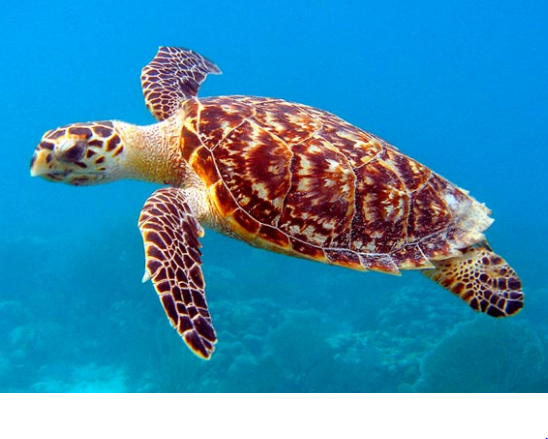
The loggerhead sea turtle (Caretta caretta), or loggerhead, is an oceanic turtle distributed throughout the world. It is a marine reptile, belonging to the family Cheloniidae. The average loggerhead measures around 90 cm (35 in) long when fully grown, although larger specimens of up to 280 cm (110 in) have been discovered. The adult loggerhead sea turtle weighs approximately 135 kg (298 lb), with the largest specimens weighing in at more than 450 kg (1,000 lb). The skin ranges from yellow to brown in color, and the shell is typically reddish brown. No external differences in sex are seen until the turtle becomes an adult, the most obvious difference being the adult males have thicker tails and shorter plastrons than the females.
The loggerhead sea turtle is found in the Atlantic, Pacific, and Indian Oceans, as well as the Mediterranean Sea. It spends most of its life in saltwater and estuarine habitats, with females briefly coming ashore to lay eggs. The loggerhead sea turtle has a low reproductive rate; females lay an average of four egg clutches and then become quiescent, producing no eggs for two to three years. The loggerhead reaches sexual maturity within 17–33 years and has a lifespan of 47–67 years.
The loggerhead sea turtle is omnivorous, feeding mainly on bottom-dwelling invertebrates. Its large and powerful jaws serve as an effective tool for dismantling its prey. Young loggerheads are exploited by numerous predators; the eggs are especially vulnerable to terrestrial organisms. Once the turtles reach adulthood, their formidable size limits predation to large marine animals, such as sharks.
Loggerheads are considered an endangered species and are protected by the International Union for the Conservation of Nature. Untended fishing gear is responsible for many loggerhead deaths. Turtles may also suffocate if they are trapped in fishing trawls. Turtle excluder devices have been implemented in efforts to reduce mortality by providing an escape route for the turtles. Loss of suitable nesting beaches and the introduction of exotic predators have also taken a toll on loggerhead populations. Efforts to restore their numbers will require international cooperation, since the turtles roam vast areas of ocean and critical nesting beaches are scattered across several countries.
Loggerhead turtles, along with green sea turtles, are the sea turtle species that are most commonly kept in captivity.